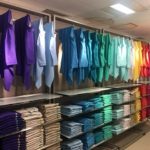Sustainability In The Fashion Industry

One of the major selling points of a business in 2019 is its approach to sustainability, thanks in part to the fact we are all now fully aware and considerably educated in regard to global warming.
In terms of the fashion retail industry, sustainability refers to the eco-friendly sourcing of the materials used to make clothes. Other factors include the working conditions of the people producing the materials, the materials total carbon footprint as well as what happens to it once it’s discarded by its owner.
Here, with Jermyn Street Design, who design pilot uniforms, we take a look at the fashion brands involved with sustainability.
Firebrands
For luxury brands, however, this was not the case. In 2017, Burberry, Britain’s largest luxury label by sales, infamously burnt around £28 million worth of clothing and cosmetics in an attempt to prevent consumers getting their hands on heavily discounted or unwanted items that weren’t going to sell at the recommended retail price. Their only justification was to maintain its brand value and reputation as a luxury fashion conglomerate.
Understandably, Burberry’s somewhat inconsiderate and rather insensitive decision to do so was met with outrage from the general public, arguing not only the ecological problems but the human aspect of homeless or poor families that could’ve had the clothes that were going to get destroyed anyway.
Perhaps more concerning than Burberry’s rash choice to set the clothes alight, is the fact they weren’t alone in doing so. Despite the brand burning almost £100m worth of stock in the last 5 years or so, this form of clothing destruction is common amongst brands in the retail sector, but Burberry got caught in the headlights.
Concerted efforts
A push from activists appeared to play some particular influence to the clothes design, however. Despite Burberry burning all their unwanted stock, they did announce towards the end of last year that going forward, not only would they be stopping this practice, they would also be stopping the use of real fur.
Burberry, have in the past, responded to a public moral outcry, protecting their brand image in the process. The ‘chav’ culture of the mid 90s adopted the brand’s trademark checked outerwear as their own and the brand soon became a stereotyped attire of the underclasses – aligning with their passion of brand names and cheap jewellery that still lives on in drabs today. Insidiously, yet ironically, these dedicated customers brought a sharp decline in sales and Burberry was forced to rebuild its esteemed front once more, stoicism doth not work in the world of modern retail.
H&M are just one example of a major clothing retailer who have made a concerted effort to become more sustainable. They announced last year that they aim to use only recycled materials by 2030 and by 2040 it wants to be 100% climate positive. Of course, it’s one thing making a bold statement but it’s another to follow up on it by implementing changes straight away. As the world’s second largest clothing retailer, they currently source 35% of materials from recycled or sustainably sourced materials, although their goal is in years to come, they still have a long way to go in order to achieve it.
Changing your outlook in regard to sustainability, doesn’t mean you have to change your style. People buy clothes because they like the aesthetics of them, and going green shouldn’t mean beige, “oatmeal-coloured fashion that are oversized or lacking in any sort of luxury” as Stella McCartney puts it, it’s a nod in the direction of the way fashion brands are being experimental when it comes to how they continuously mould their strategies.
What contributes towards a bad fashion footprint?
Despite the fact clothing manufacturers and retailers have been placing somewhat of a focus on reducing their carbon footprint, including sustainable cotton initiatives to reduce the amount of water used, as well as monitoring energy and chemical use, the balance has actually tilted in the direction of the consumer.
Now, in 2019, with virtually the entire human population being connected to social media, there exists a major focus on staying fresh, and in touch with trend. That said the unquenchable desire means people are buying more and more clothes, in fact, since 2012, the amount of clothes we have purchased has risen 10%. Not only are we buying more, the rate at which they’re getting discarded is also increasing.
Sources
